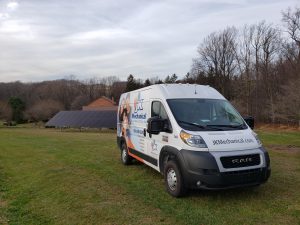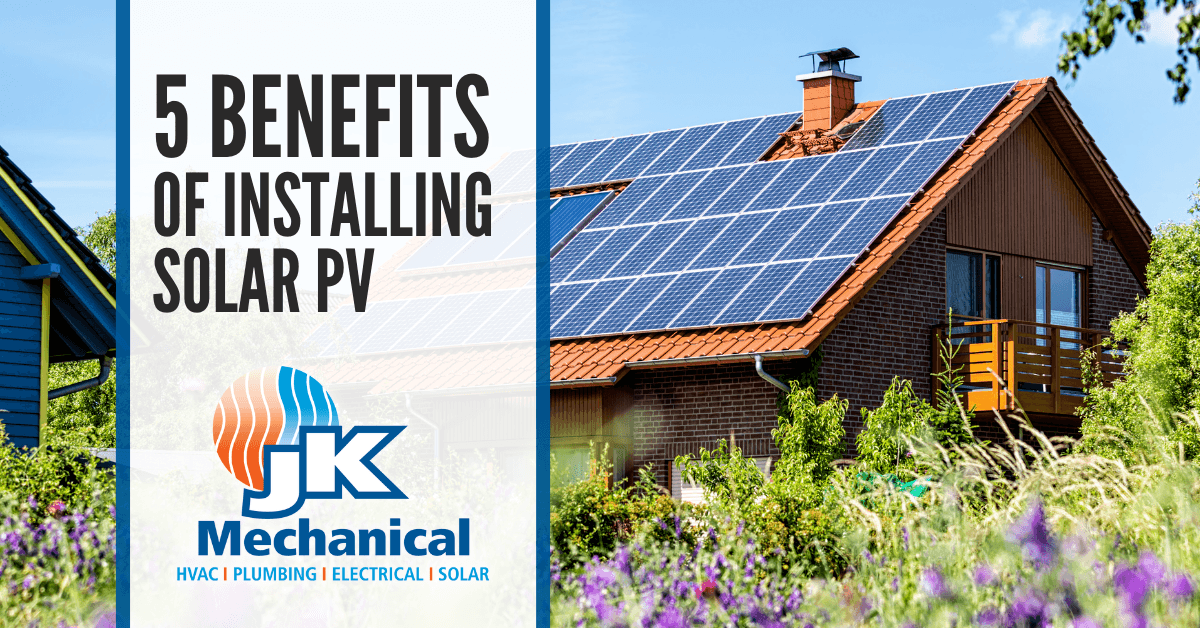Five Benefits of Solar PV
If only 0.0005% of the earth were covered with solar energy systems, we could power the entire planet. Powering your home or business with solar PV offers a number of benefits to your home or facility, finances, sustainability, and more. Today on the JK Blog we discuss five benefits to installing a Solar PV array:
Financial Savings
Typically, the financial incentives to collecting/producing your own electricity are the #1 reason we see clients explore Solar PV installation. While this fluctuates based off equipment availability and costs, we currently anticipate an 8-10 year payback time on an average residential array. That includes the current 26% Federal Tax Credit on residential systems, which was recently extended through the end of 2022. (Edit 10/2022: The federal tax credit has now been expanded to 30% through 2033 and includes solar battery backup for the first time.) Many homeowners are able to significantly offset or fully eliminate their monthly electric bills by installing solar panels on their existing roof space. With increased electric costs from all of our local suppliers this summer, the idea of reducing or even eliminating that power bill is certainly appealing.
For example, at the JK office in Willow Street, we are better than net zero. On a 12-month basis, our 11-year-old rooftop solar array produces an average of 10,000 kWh more per year than our entire office and warehouse consumes. That excess production is sold back to the power company and put back on the grid.
Sustainability
According to the U.S. Environmental Protection Agency, the average household emits approximately 20 metric tons of carbon pollution each year. After the initial carbon footprint of the production, transport, and install of the solar panels, your solar PV array will produce clean, renewable power with no emissions for years to come. By installing a solar power system, a typical two-person household reduces their carbon emissions by three to four tons annually. Solar panels are a convenient, low-maintenance way to reduce your household emissions while also saving on your utility bills.
With the growing electrification movement in the US, JK President (and residential solar PV owner) Chris Leaman anticipates that solar power will only become more common: “To me, it’s a logical move. Solar panels produce power at the point of consumption, meaning there’s no energy wasted to transport or move it. We already have the roof space; we may as well put it to good use.”
Higher Home Values
The Office of Energy Efficiency and Renewable Energy reports that a solar energy system will likely increase a home’s value, and that buyers across the country have been willing to pay an increase of approximately $15,000 for a home with an average-sized solar array.
As a note—this typically only applies to owned solar arrays (panels owned by the home or facility owner), not leased arrays. If you have a leased array, the solar owner or your realter should offer guidance on how the array affects the sale/purchase of your home.
(Very) Low Maintenance
Unlike your HVAC system, which works best, safely, and most efficiently with regular professional maintenance, the vast majority of solar arrays require little to no routine maintenance. Normal precipitation will clean all but the dirtiest of solar panels—if you are really concerned, they can be gently washed with a non-abrasive cloth and water. If you have a ground-mount array, you’ll want to be sure that any especially tall vegetation is mowed or trimmed back from the array. Otherwise, as long as you’re continuing to see credit on your utility bill, your solar array should continue to perform as expected for years to come.
One caveat: if you live in a very squirrel-heavy area, occasionally we have seen squirrels cause damage by nesting under the panels (and chewing whatever they need to in order to make themselves comfortable). In these areas, we recommend adding a squirrel guard such as SolaTrim in order to protect your array and prevent costly repairs. This can be added at the time of construction, or retrofitted to most existing roof-mount arrays. In normal circumstances, however, your solar array will work just fine on its own.
Solar Renewable Energy Credits
The Pennsylvania Renewable Portfolio Standard (RPS) requires electricity suppliers to secure a portion of their electricity from solar and other green generators. To achieve AEPSA compliance, local energy companies are willing to pay you for energy generated by your residential solar system. One Solar Renewable Energy Certificate (SREC) is created for every megawatt-hour (MWH) of solar electricity. Aggregators, such as JK Mechanical, report and sell the SRECs on your behalf and cut solar owners a check. As a commodity, SREC prices fluctuate based on supply and demand. While this means that SREC payments aren’t typically a huge factor in your solar savings or payback time, every little bit helps and they are certainly a welcome bonus to the direct savings realized by your array. Plus, if you have JK Mechanical as your aggregator and maintain active solar internet production monitoring, we can register, sell, and send a check for your SRECs without any additional work on your part.
Want to learn more about solar PV? The install process tends to take some time due to power company and municipality approvals. Start the process early and contact us here for your free assessment.



